check engine VOLVO XC70 2003 Owner's Manual
[x] Cancel search | Manufacturer: VOLVO, Model Year: 2003, Model line: XC70, Model: VOLVO XC70 2003Pages: 257, PDF Size: 5.33 MB
Page 153 of 257

2003 VOLVO XC70
Cold weather precautions
If you wish to check your car before the approach of cold weather, the f\
ollowing advice is worth noting:
l Make sure that the engine coolant contains 50 percent antifreeze. Any ot\
her mixture will reduce
freeze protection. This gives protection against freezing down to -31°\
F (-35°C). See section "Coolant".
The use of "recycled" antifreeze is not approved by Volvo. Different typ\
es of antifreeze must not
be mixed.
l Volvo recommends using only genuine Volvo antifreeze in your car's radia\
tor. Your local Volvo
retailer stocks plenty of Volvo engine coolant to protect your car durin\
g cold weather.
l Try to keep the fuel tank well filled - this prevents the formation of condensation in the tank. \
In
addition, in extremely cold weather conditions it is worthwhile to add f\
uel line de-icer before refueling.
l The viscosity of the engine oil is important. Oil with low viscosity (thinner oil) improves cold-
weather starting as well as decreasing fuel consumption while the engine\
is warming up. For winter use,
5W-30 oil, particularly the synthetic type *, is recommended. Be sure to\
use good quality oil but do not
use this cold-weather oil for hard driving or in warm weather. See section "Engine oil" for more
information.
l The load placed on the battery is greater during the winter since the windshield wipers, lighting, etc\
.
are used more often. Moreover, the capacity of the battery decreases as \
the temperature drops. In very
cold weather, a poorly charged battery can freeze and be damaged. It is \
therefore advisable to check the
state of charge more frequently and spray an anti-rust oil on the batter\
y posts.
l Volvo recommends the use of snow tires on all four wheels for winter dri\
ving - see section "Wheels
and tires".
l To prevent the washer fluid reservoir from freezing, add washer solvents\
containing antifreeze (see
page 130 for the location of the washer fluid reservoir). This is important sin\
ce dirt is often splashed on
the windshield during winter driving, requiring the frequent use of the \
washers and wipers. The Volvo
Washer Solvent should be diluted as follows:
Down to 14° F (-10° C): 1 part washer solvent and 4 parts water \
Down to 5° F (-15° C): 1 part washer solvent and 3 parts water
Down to 0° F (-18° C): 1 part washer solvent and 2 parts water
Down to -18° F (-28° C): 1 part washer solvent and 1 part water \
l Use Volvo Teflon Lock Spray in the locks.
NOTE: Avoid the use of de-icing sprays as they can cause damage to the locks.
W Winter/Wet driving mode - enhanced vehicle traction
l Mode W will only function if the gear selector is in the (D)rive posit\
ion.
l Press the button at the base of the gear selector to engage/disengage th\
is driving mode (see
illustration).
l An LED in the button will light up to indicate that W is engaged and this will also be displayed in the
instrument panel (see
page 27).
l This mode may be selected for starting/moving off on slippery roads.
file:///K|/ownersdocs/2003/2003_XC70/03xc70_06b.htm (8 of 10)12/30/200\
6 4:18:00 PM
Page 154 of 257
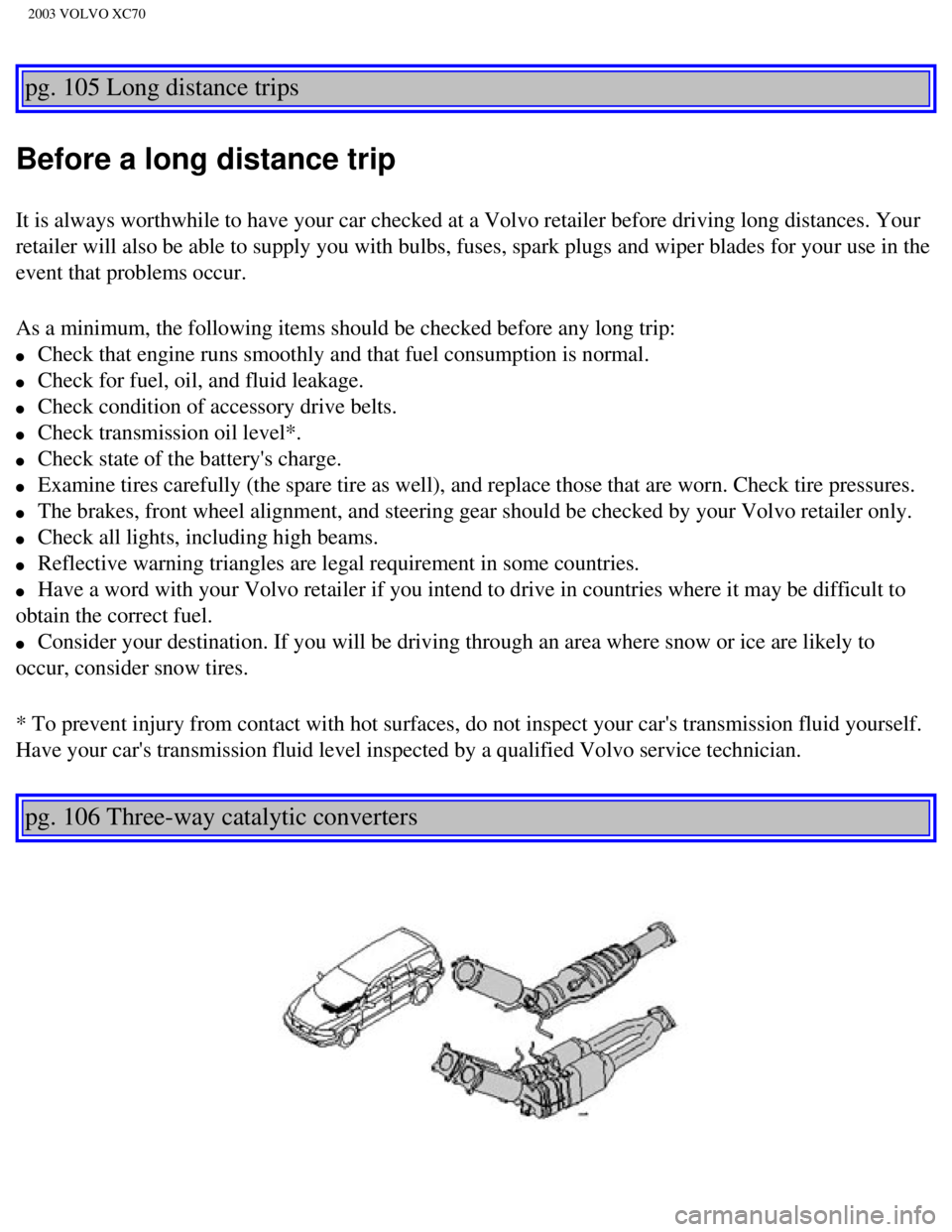
2003 VOLVO XC70
pg. 105 Long distance trips
Before a long distance trip
It is always worthwhile to have your car checked at a Volvo retailer bef\
ore driving long distances. Your
retailer will also be able to supply you with bulbs, fuses, spark plugs \
and wiper blades for your use in the
event that problems occur.
As a minimum, the following items should be checked before any long trip\
:
l Check that engine runs smoothly and that fuel consumption is normal.
l Check for fuel, oil, and fluid leakage.
l Check condition of accessory drive belts.
l Check transmission oil level*.
l Check state of the battery's charge.
l Examine tires carefully (the spare tire as well), and replace those th\
at are worn. Check tire pressures.
l The brakes, front wheel alignment, and steering gear should be checked b\
y your Volvo retailer only.
l Check all lights, including high beams.
l Reflective warning triangles are legal requirement in some countries.
l Have a word with your Volvo retailer if you intend to drive in countries\
where it may be difficult to
obtain the correct fuel.
l Consider your destination. If you will be driving through an area where \
snow or ice are likely to
occur, consider snow tires.
* To prevent injury from contact with hot surfaces, do not inspect your \
car's transmission fluid yourself.
Have your car's transmission fluid level inspected by a qualified Volvo \
service technician.
pg. 106 Three-way catalytic converters
file:///K|/ownersdocs/2003/2003_XC70/03xc70_06b.htm (9 of 10)12/30/200\
6 4:18:00 PM
Page 181 of 257
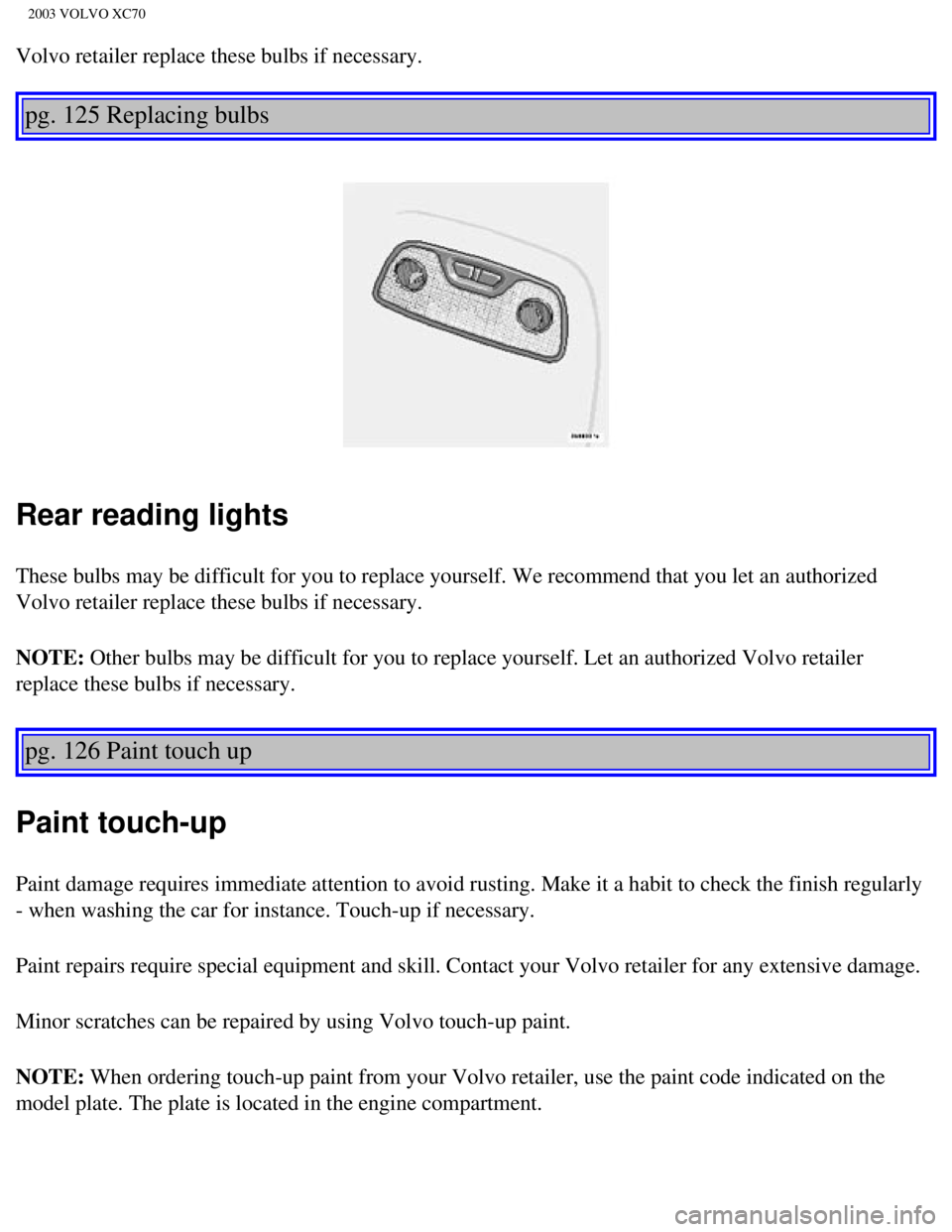
2003 VOLVO XC70
Volvo retailer replace these bulbs if necessary.
pg. 125 Replacing bulbs
Rear reading lights
These bulbs may be difficult for you to replace yourself. We recommend t\
hat you let an authorized
Volvo retailer replace these bulbs if necessary.
NOTE: Other bulbs may be difficult for you to replace yourself. Let an author\
ized Volvo retailer
replace these bulbs if necessary.
pg. 126 Paint touch up
Paint touch-up
Paint damage requires immediate attention to avoid rusting. Make it a ha\
bit to check the finish regularly
- when washing the car for instance. Touch-up if necessary.
Paint repairs require special equipment and skill. Contact your Volvo re\
tailer for any extensive damage.
Minor scratches can be repaired by using Volvo touch-up paint.
NOTE: When ordering touch-up paint from your Volvo retailer, use the paint cod\
e indicated on the
model plate. The plate is located in the engine compartment.
file:///K|/ownersdocs/2003/2003_XC70/03xc70_08a.htm (16 of 21)12/30/20\
06 4:18:03 PM
Page 188 of 257
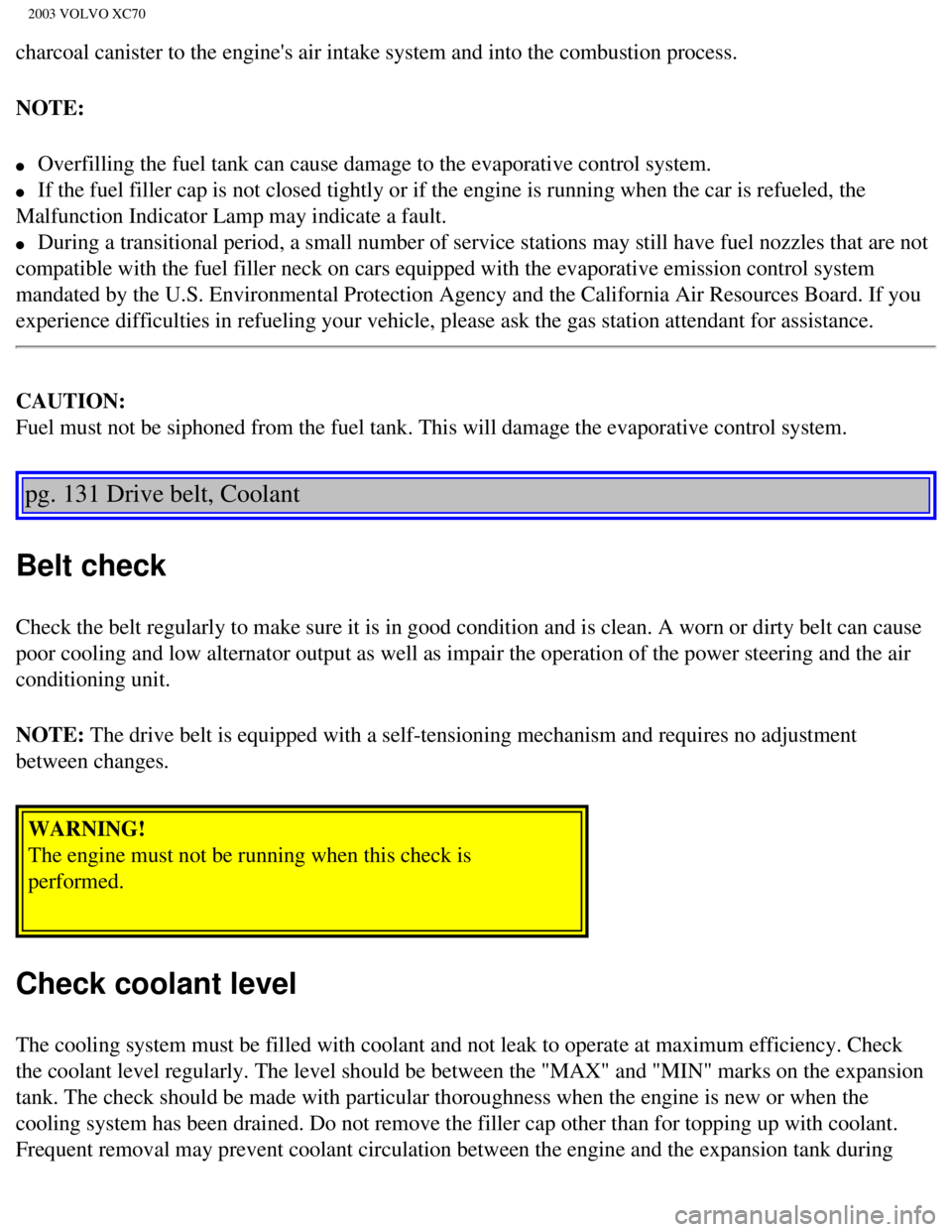
2003 VOLVO XC70
charcoal canister to the engine's air intake system and into the combust\
ion process.
NOTE:
l Overfilling the fuel tank can cause damage to the evaporative control sy\
stem.
l If the fuel filler cap is not closed tightly or if the engine is running\
when the car is refueled, the
Malfunction Indicator Lamp may indicate a fault.
l During a transitional period, a small number of service stations may sti\
ll have fuel nozzles that are not
compatible with the fuel filler neck on cars equipped with the evaporati\
ve emission control system
mandated by the U.S. Environmental Protection Agency and the California \
Air Resources Board. If you
experience difficulties in refueling your vehicle, please ask the gas st\
ation attendant for assistance.
CAUTION:
Fuel must not be siphoned from the fuel tank. This will damage the evapo\
rative control system.
pg. 131 Drive belt, Coolant
Belt check
Check the belt regularly to make sure it is in good condition and is cle\
an. A worn or dirty belt can cause
poor cooling and low alternator output as well as impair the operation o\
f the power steering and the air
conditioning unit.
NOTE: The drive belt is equipped with a self-tensioning mechanism and requires\
no adjustment
between changes.
WARNING!
The engine must not be running when this check is
performed.
Check coolant level
The cooling system must be filled with coolant and not leak to operate a\
t maximum efficiency. Check
the coolant level regularly. The level should be between the "MAX" and "\
MIN" marks on the expansion
tank. The check should be made with particular thoroughness when the eng\
ine is new or when the
cooling system has been drained. Do not remove the filler cap other than\
for topping up with coolant.
Frequent removal may prevent coolant circulation between the engine and \
the expansion tank during
file:///K|/ownersdocs/2003/2003_XC70/03xc70_08b.htm (2 of 16)12/30/200\
6 4:18:04 PM
Page 190 of 257

2003 VOLVO XC70
more often when the vehicle is driven under dirty and dusty conditions. \
The cartridge cannot be cleaned,
and should always be replaced with a new one.
Fuel filter
The fuel filter should be replaced at 105,000 miles (168,000 km) or at\
120,000 miles (193,000 km) for
the 2.5T engine on AWD models. The filter is replaced as a complete unit\
. Replace more frequently if
contaminated fuel is introduced into the tank, or if there is reason to \
suspect that this has occurred.
Fuel system, including filler cap, tank and lines and
connections
The ability of the fuel system to contain hydrocarbons depends upon a le\
ak-free system. Inspect fuel
lines every 30,000 miles (48,000 km).Check for proper sealing of the f\
uel filler cap which contains "O"
ring seals.
NOTE: If the fuel filler cap is not closed tightly or if the engine is running\
when the car is refueled, the
Check Engine light (Malfunction indicator) may indicate a fault. Howev\
er, your vehicle's performance
will not be affected. Use only Volvo original or approved fuel filler ca\
ps.
Timing belt
For proper functioning of the vehicle and its emission control systems, \
the timing belt and belt tensioner
must be replaced every 105,000 miles (168,000 km) or at 120,000 miles \
(193,000 km) for the 2.5T
engine on AWD models. Engine damage will occur if the belt fails.
PCV system
(on turbocharged models)
The nipple in the intake manifold and the filter at the end of the PCV h\
ose in the air cleaner should be
inspected and cleaned at 105,000 miles (168,000 km) and thereafter, ag\
ain at 150,000 mile (240,000 km)
intervals.
Spark plugs
The spark plugs should be replaced every 60,000 miles (96,000 km) unde\
r normal driving conditions.
City driving or fast highway driving may necessitate replacement sooner.\
Under normal driving conditions, spark plugs require no maintenance betw\
een replacement intervals.
file:///K|/ownersdocs/2003/2003_XC70/03xc70_08b.htm (4 of 16)12/30/200\
6 4:18:04 PM
Page 191 of 257
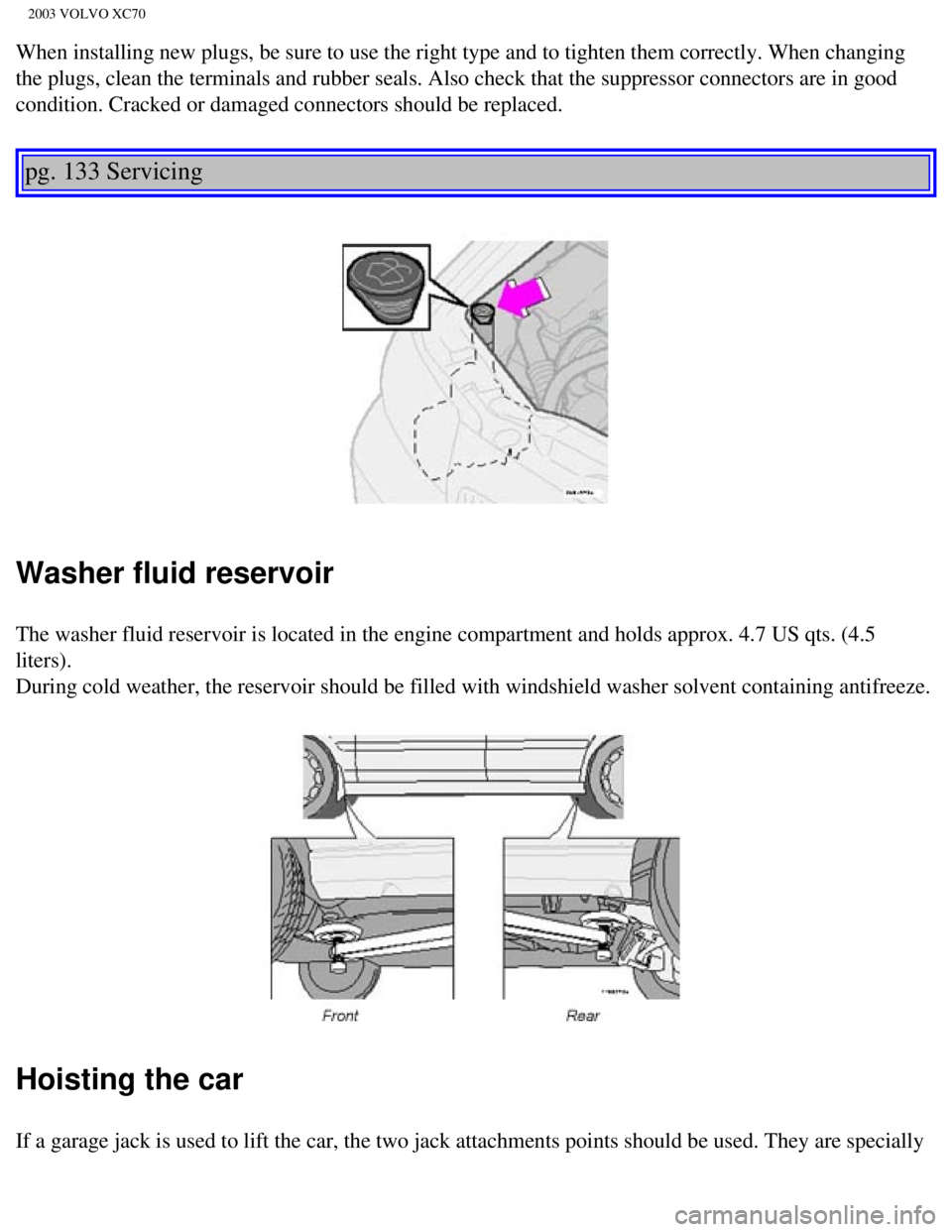
2003 VOLVO XC70
When installing new plugs, be sure to use the right type and to tighten \
them correctly. When changing
the plugs, clean the terminals and rubber seals. Also check that the sup\
pressor connectors are in good
condition. Cracked or damaged connectors should be replaced.
pg. 133 Servicing
Washer fluid reservoir
The washer fluid reservoir is located in the engine compartment and hold\
s approx. 4.7 US qts. (4.5
liters).
During cold weather, the reservoir should be filled with windshield wash\
er solvent containing antifreeze.
Hoisting the car
If a garage jack is used to lift the car, the two jack attachments point\
s should be used. They are specially
file:///K|/ownersdocs/2003/2003_XC70/03xc70_08b.htm (5 of 16)12/30/200\
6 4:18:04 PM
Page 192 of 257
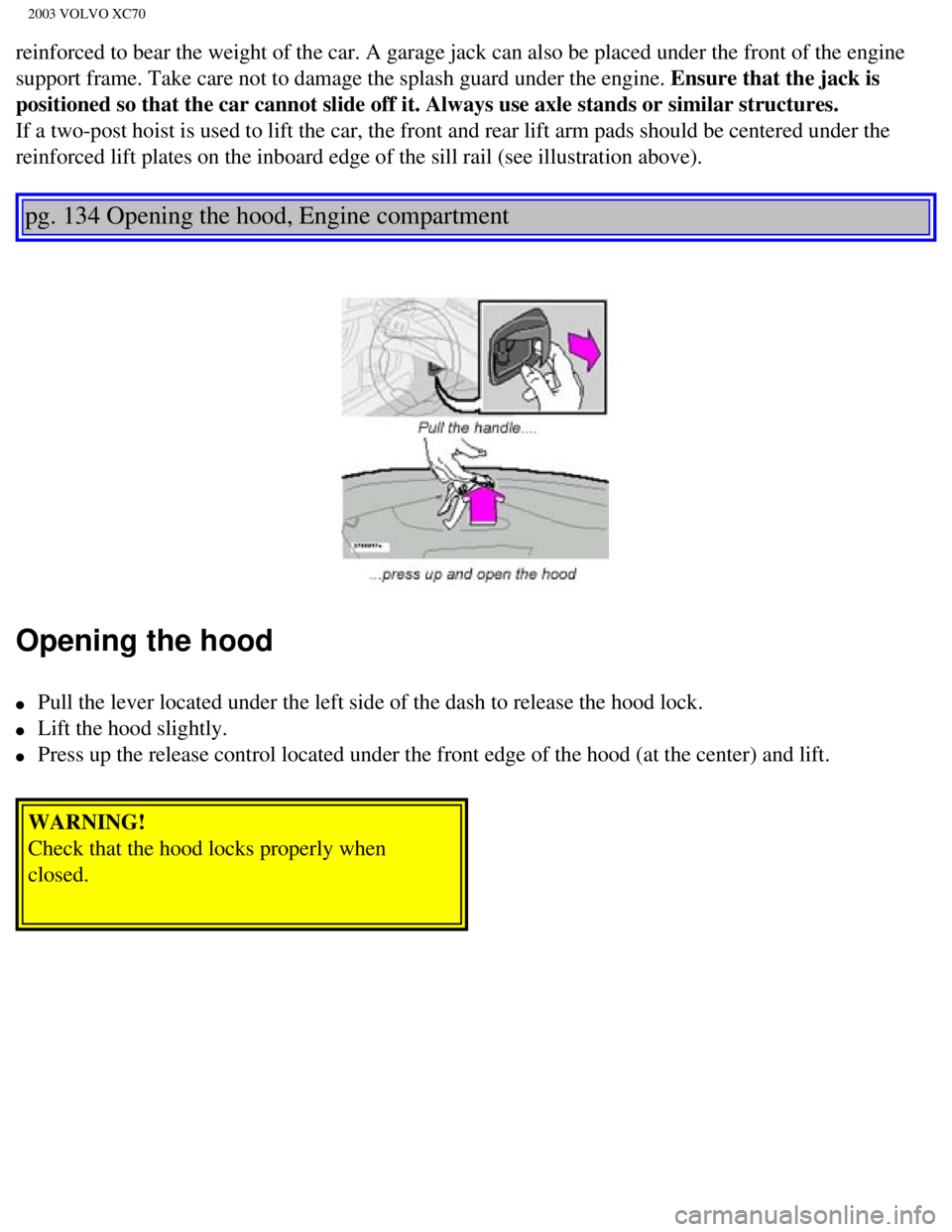
2003 VOLVO XC70
reinforced to bear the weight of the car. A garage jack can also be plac\
ed under the front of the engine
support frame. Take care not to damage the splash guard under the engine\
. Ensure that the jack is
positioned so that the car cannot slide off it. Always use axle stands o\
r similar structures.
If a two-post hoist is used to lift the car, the front and rear lift arm\
pads should be centered under the
reinforced lift plates on the inboard edge of the sill rail (see illust\
ration above).
pg. 134 Opening the hood, Engine compartment
Opening the hood
l Pull the lever located under the left side of the dash to release the ho\
od lock.
l Lift the hood slightly.
l Press up the release control located under the front edge of the hood (\
at the center) and lift.
WARNING!
Check that the hood locks properly when
closed.
file:///K|/ownersdocs/2003/2003_XC70/03xc70_08b.htm (6 of 16)12/30/200\
6 4:18:04 PM
Page 195 of 257
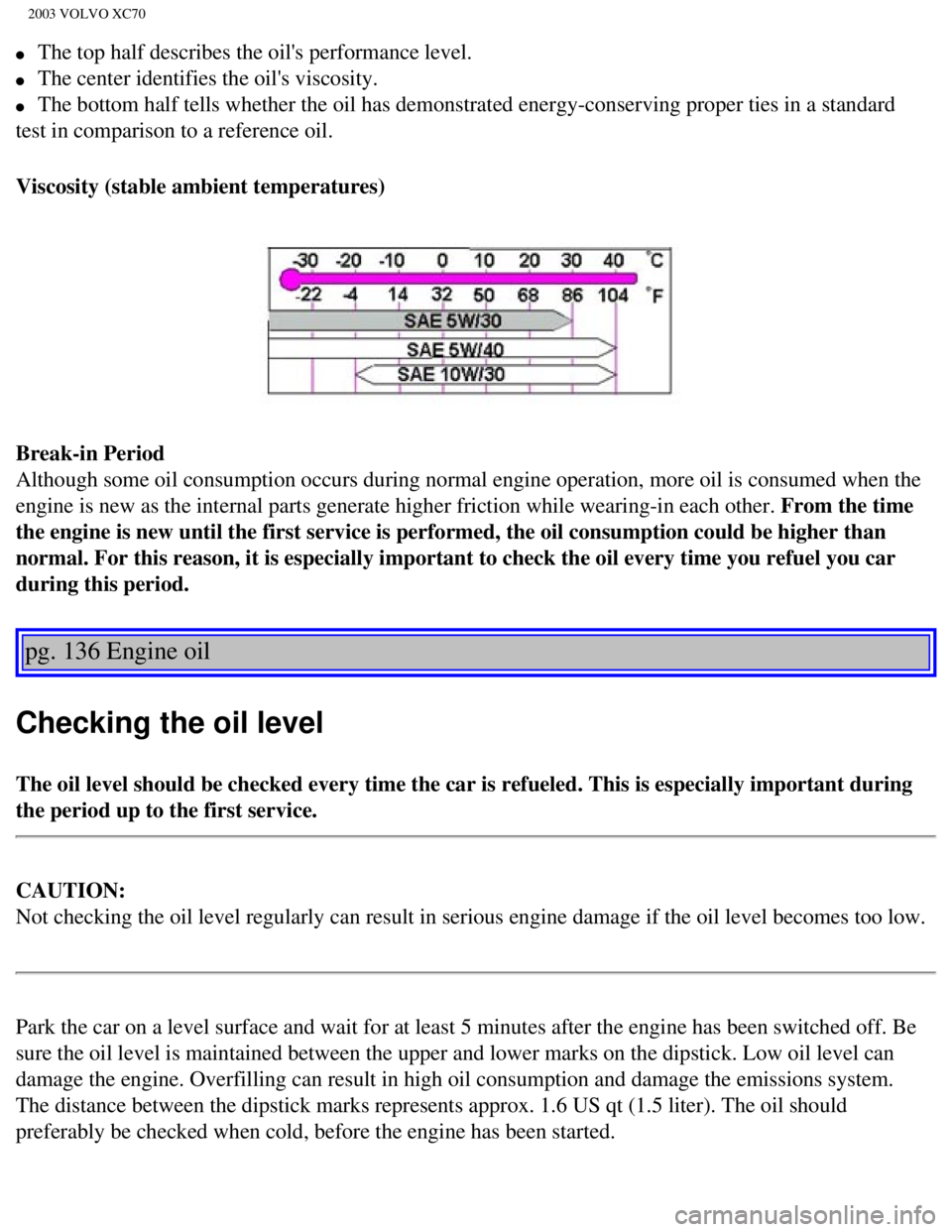
2003 VOLVO XC70
l The top half describes the oil's performance level.
l The center identifies the oil's viscosity.
l The bottom half tells whether the oil has demonstrated energy-conserving\
proper ties in a standard
test in comparison to a reference oil.
Viscosity (stable ambient temperatures)
Break-in Period
Although some oil consumption occurs during normal engine operation, mor\
e oil is consumed when the
engine is new as the internal parts generate higher friction while weari\
ng-in each other. From the time
the engine is new until the first service is performed, the oil consumpt\
ion could be higher than
normal. For this reason, it is especially important to check the oil eve\
ry time you refuel you car
during this period.
pg. 136 Engine oil
Checking the oil level
The oil level should be checked every time the car is refueled. This is \
especially important during
the period up to the first service.
CAUTION:
Not checking the oil level regularly can result in serious engine damage\
if the oil level becomes too low.
Park the car on a level surface and wait for at least 5 minutes after th\
e engine has been switched off. Be
sure the oil level is maintained between the upper and lower marks on th\
e dipstick. Low oil level can
damage the engine. Overfilling can result in high oil consumption and da\
mage the emissions system.
The distance between the dipstick marks represents approx. 1.6 US qt (1\
.5 liter). The oil should
preferably be checked when cold, before the engine has been started.
file:///K|/ownersdocs/2003/2003_XC70/03xc70_08b.htm (9 of 16)12/30/200\
6 4:18:04 PM
Page 196 of 257
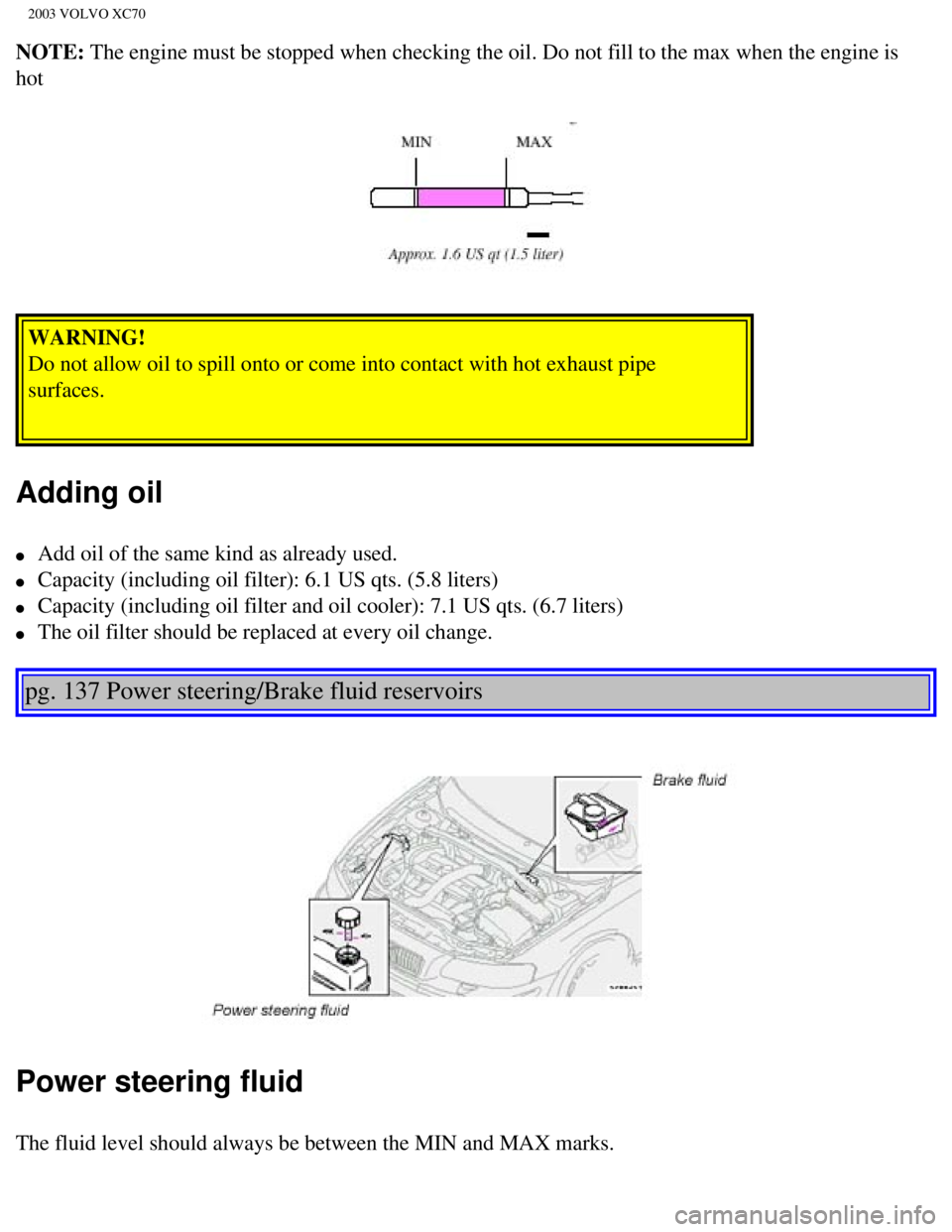
2003 VOLVO XC70
NOTE: The engine must be stopped when checking the oil. Do not fill to the max\
when the engine is
hot
WARNING!
Do not allow oil to spill onto or come into contact with hot exhaust pip\
e
surfaces.
Adding oil
l Add oil of the same kind as already used.
l Capacity (including oil filter): 6.1 US qts. (5.8 liters)
l Capacity (including oil filter and oil cooler): 7.1 US qts. (6.7 lite\
rs)
l The oil filter should be replaced at every oil change.
pg. 137 Power steering/Brake fluid reservoirs
Power steering fluid
The fluid level should always be between the MIN and MAX marks.
file:///K|/ownersdocs/2003/2003_XC70/03xc70_08b.htm (10 of 16)12/30/20\
06 4:18:04 PM
Page 198 of 257

2003 VOLVO XC70
l Check the fluid level in each cell in the battery every 24 months or eve\
ry 15,000* miles (24,000 km),
whichever is sooner. The fluid should be at the level shown in the illus\
tration above (A**).
Use a screwdriver to open the caps and a flashlight to inspect the level\
.
l If necessary, add distilled water. The level should never be above the indicator (A).
l The fluid level should be checked if the battery has been recharged.
l After inspection, be sure the cap over each battery cell is securely in \
place.
l Check that the battery cables are correctly connected and properly tight\
ened.
l Never disconnect the battery when the engine is running, for example whe\
n changing the battery.
l The battery should be disconnected from the vehicle when a battery charg\
er is used directly on the
battery. However, if the battery is being charged via the connecting poi\
nts in the engine compartment
(see
page 101), the battery must be connected.
PROPOSITION 65 WARNING!
Battery posts, terminals, and related accessories contain lead and lead \
compounds, chemicals known
to the state of California to cause cancer and reproductive harm. Wash h\
ands after handling.
* More frequently in warm climates.
** The level indicator inside the battery could be designed in various w\
ays. See illustration above!
Battery warning symbols Battery warning symbols
file:///K|/ownersdocs/2003/2003_XC70/03xc70_08b.htm (12 of 16)12/30/20\
06 4:18:04 PM